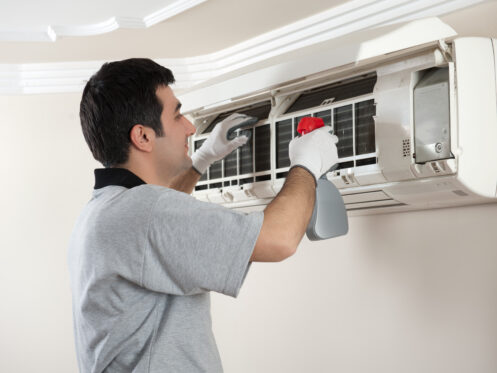Adding a home office, gym or entertainment space to a home can greatly improve a person’s standard of living. It allows people to customize their homes to fit their changing lifestyles while also increasing their resale value. By integrating a ductless mini-split system into the addition, homeowners can achieve year-round comfort thanks to perfect climate control across the whole home.
What Is a Ductless Mini Split?
A ductless mini-split system is a type of heating and cooling system that provides climate control without the need for ductwork. It has an outdoor unit and refrigerant lines that link it to one or more inside units. There are various types of systems, including single-zone and multi-zone configurations.
In a single-zone system, one outdoor unit connects to a single indoor unit, providing heating and cooling to a specific area or room. With a multi-zone system, you can manage the temperature in each zone separately by connecting one outside unit to multiple interior units. A multi-zone HVAC system works best in homes with varying heating and cooling needs across different areas or levels.
Mini splits transfer heat between the indoor and outdoor units using refrigerant. During the cooling process, the indoor unit absorbs heat from the room air and transfers it to the outdoor unit, releasing it. The process reverses when it switches to heat mode. In this mode, the system takes the heat absorbed from outdoor air and transfers it indoors. This efficient heat exchange process provides consistent and comfortable indoor temperatures throughout the year.
Space-saving Design
Mini-split systems offer several features that contribute to their space-saving design, making them ideal for home additions. They eliminate the need for bulky ductwork, freeing up valuable floor space. The compact size of the indoor units allows for flexible installation options, such as wall-mounted or ceiling-mounted units, further maximizing space utilization. These systems provide targeted heating and cooling without the need for extensive ductwork, ensuring efficient use of available space.
Zoned HVAC
Home additions often present unique heating and cooling challenges due to varying layouts and usage patterns. Zoned HVAC systems, particularly ductless mini splits, offer tailored comfort solutions for these spaces. Their flexibility allows for precise temperature control in individual zones, ensuring optimal comfort regardless of the addition’s size or layout.
Cost-effectiveness
When adding an addition to a home, cost-effectiveness is a key consideration. Mini splits offer several advantages in this regard. Their zoned heating and cooling capabilities allow for targeted temperature control, reducing energy waste. Additionally, the absence of ductwork simplifies installation and lowers upfront costs. Moreover, ductless mini splits are highly energy-efficient, resulting in lower utility bills over time. Their durability and long life span further contribute to cost savings by reducing maintenance and replacement expenses.
Low Maintenance Requirements
Mini splits boast low maintenance requirements, making them an attractive option for homeowners seeking convenience and peace of mind. Unlike traditional HVAC systems with complex ductwork, ductless mini splits have fewer components that need regular upkeep. Routine maintenance typically involves cleaning or replacing filters and ensuring the outdoor unit remains free of debris. With minimal maintenance demands, homeowners can enjoy reliable heating and cooling without the hassle of frequent service calls or extensive upkeep schedules.
Smaller Carbon Footprint
Another standout feature of mini-split systems is their ability to reduce the carbon footprint of a home. By using advanced technologies such as inverter-driven compressors and variable-speed fans, ductless mini splits optimize energy usage, resulting in lower utility bills and reduced greenhouse gas emissions. With a smaller carbon footprint, homeowners can feel good about their environmental impact while enjoying comfortable indoor temperatures year-round in the new addition.
Quiet Operation
Unlike window air conditioners or traditional central HVAC systems, which can be noisy and disruptive, mini splits operate quietly, thanks to their compact and insulated design. With quiet operation, homeowners can enjoy the comfort of their home addition without the distraction of loud HVAC equipment, enhancing overall comfort and satisfaction.
Remote Control Functionality
Many mini splits offer remote control functionality, allowing homeowners to conveniently adjust temperature settings and fan speeds from anywhere in the room. This feature is particularly beneficial for home additions, as it provides effortless climate control without needing to access the unit physically. Homeowners can easily regulate the temperature to their preference, ensuring comfort throughout the newly added space.
Improved Property Value
There are a number of ways in which a mini split addition might raise a home’s value. First, it increases the property’s attractiveness and desirability by making it more comfortable and convenient for prospective purchasers. Furthermore, ductless mini splits might entice eco-conscious consumers who prioritize sustainability and reduce electricity bills due to their energy efficiency. Ductless systems are highly adaptable, allowing homeowners to create heating and cooling solutions that are uniquely suited to their needs. This, in turn, increases the value of their house. In addition, they provide a contemporary touch to the house, making it more attractive and marketable. This can also boost the property’s resale value.
Some Special Considerations
It’s crucial to accurately size the mini-split system to match the heating and cooling needs of the new space. A professional HVAC technician can assess factors such as the size of the addition, insulation levels and local climate to determine the appropriate system capacity. It is also essential to position the interior air handler units correctly so that the new room has efficient circulation and uniform temperature distribution. Strategic positioning of the units, typically mounted high on walls or ceilings, helps maximize usable floor space and minimize obstructions.
Homeowners should consider the aesthetic impact of the mini split on the interior and exterior design of the home addition. Opting for sleek and modern air handler units that complement the existing decor can enhance the space’s overall appeal. Another important consideration is the electrical requirements for installing the mini-split system. Ensuring that the electrical infrastructure can support the additional load from the new HVAC system will help prevent overloading circuits and potential safety hazards.
In order to optimize the energy efficiency and comfort levels in a new addition to a home, you will need to ensure proper insulation and sealing. Well-insulated walls, floors and ceilings help minimize heat transfer and reduce energy loss, allowing the mini split to operate more efficiently.
Homeowners should also factor in the long-term maintenance needs of the ductless mini-split system when planning for the home addition. Regular cleaning and maintenance of the air handler units and periodic inspections by HVAC professionals are necessary to ensure reliable performance and extend the system’s life span.
Environmental Heating & Air Solutions specializes in helping homeowners with heating and cooling installations, repairs and maintenance. We also offer 24/7 emergency repairs, air quality and plumbing services in Benicia, Roseville and the surrounding areas. To speak with a licensed technician for more information about any of our offerings or to schedule an appointment, call Environmental Heating & Air Solutions now.

